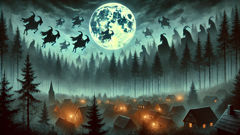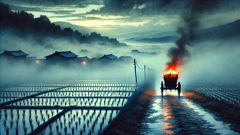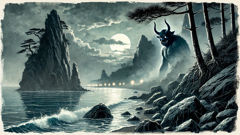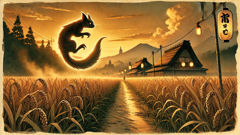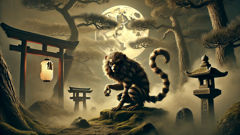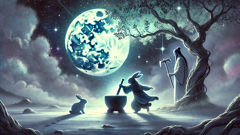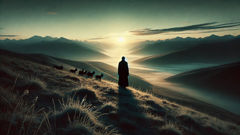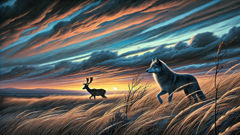Introduction
In the twilight hush of the 18th-century Dutch-German borderlands, mist curls above the moors and forests like restless spirits. The ancient trees of Limburg stand thick and close, their branches knotted as if to shelter secrets whispered through generations. Here, beneath the pale gaze of the moon, a legend was born—one that would chill the hearts of farmers and townsfolk for decades, inspiring awe, dread, and the uneasy feeling that, perhaps, the world held more than met the eye. This was the domain of the Buckriders—the Bokkenrijders—bandits who, it was said, made a pact with the devil to soar upon the backs of goats, swooping down on isolated farms with otherworldly speed and stealth. The very name became a warning and a curse. Children lay awake listening to the wind, wondering if it was the bleating of a goat or the arrival of the dreaded gang. Villagers clutched talismans and whispered prayers as shadows flickered across their candlelit walls. In this borderland, where faith, fear, and folklore intermingled, truth became as elusive as the riders themselves. Yet every legend begins with a kernel of reality. In a time of poverty and suspicion, when church bells rang out both for worship and warning, a wave of crime swept the countryside. The robberies were real; the terror tangible. But it was the stories—the tales of flying goats and infernal bargains—that spread fastest of all. This is the legend as it lives in the hearts of those who dwelled in those fog-bound valleys: a tale not just of thieves, but of the darkness that grows when fear takes root, and of the light that flickers in even the most shadowed places.
I. The Whispering Woods
The wind hissed through the trees, carrying with it the secrets of the borderlands. In the hamlet of Oud-Heerlen, the nights were heavy with dread. Each family gathered around their hearth, clutching rosaries, whispering the Lord’s Prayer, and bolting doors as the sun slipped away. The old ways held sway here; faith and superstition intertwined so tightly that few dared separate one from the other.
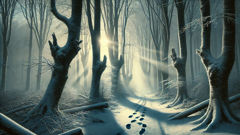
It was an especially bitter winter in 1772. The peat fires burned low, and hunger gnawed at bellies. The fields lay barren, the cattle thin. Strange footprints appeared in the snow: cloven marks, too large for any ordinary goat. By morning, smoke would curl from ruined barns and storerooms. Livestock vanished; grain stores were pillaged. No one ever saw the culprits arrive or flee—only the faint, chilling sound of distant bleating and the rush of hooves overhead.
Jan Kessels, the village blacksmith, had grown up with the stories. His father spoke of a time when the Buckriders came only in dreams and whispered warnings. Now, they were all too real. Each new crime became more brazen—each rumor more fantastical. It was said that the Buckriders signed their names in the Devil’s book, gaining the power to fly on goats through the night sky. Some villagers claimed they saw fire in the bandits’ eyes, or that they could pass through walls like smoke. Suspicion blossomed like mold in the damp corners of every mind. Neighbors eyed each other warily. Who among them might be in league with darkness?
Jan’s hammer fell with extra force as he worked late into the night. He could not shake the unease that crept in with every new tale. One evening, as he returned from the smithy, he spotted a pale figure lingering by the old willow at the edge of the woods. It was Katrijn, his childhood friend—now a widow, her eyes hollow with grief. Her husband, once a watchman, had vanished two months earlier during a night of Buckrider raids.
“Jan,” she whispered, “there are voices in the forest tonight. They call to me—like goats, but twisted, wrong.”
He tried to reassure her, but the fear in her voice burrowed deep. That night, as he lay in bed, Jan listened to the wind. It carried a strange, guttural bleating—a sound that sent shivers up his spine. A low thud echoed across the rooftops, and he swore he heard laughter: rough, mocking, not entirely human. He rose, peering out into the pale wash of moonlight. Something moved at the edge of the woods—swift, hunched, and gone before he could truly see it.
The next morning, word spread that old Pieter’s cows had vanished without a trace. Tracks—deep, cloven, and curiously large—led straight into the forest, where they vanished among tangled roots and mist. The village council gathered in the church, voices rising in panic. The priest, Father Verhoeven, thundered from the pulpit that these were signs of Satan’s work. “Repent! Pray!” he cried. “The Buckriders are agents of evil sent to test our faith!”
Doubt crept into Jan’s mind. He wondered if the real evil was not simply the desperation of men pressed too far. Yet, when he looked into Katrijn’s haunted eyes or listened to the children’s fearful cries, even he found himself half-believing in flying robbers and infernal bargains. The line between reality and legend blurred with every cold, restless night.
II. The Pact and the Pursuit
Fear pressed in on Oud-Heerlen like a second winter. Each new crime fed the legend; each accusation set neighbor against neighbor. The Buckriders seemed unstoppable—unseen phantoms who struck where least expected. But not all believed their power supernatural. Hendrik Meessen, a traveling magistrate from Maastricht, arrived under the pretense of restoring order. Tall and severe, his boots muddied by miles of icy road, Hendrik carried a sheaf of warrants and a mind sharpened by skepticism.
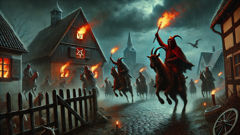
He began with questions—endless questions. Who had seen what? Who had heard what? The villagers’ answers were uncertain, colored by fear and folk tales. Jan watched Hendrik work, torn between relief and suspicion. The magistrate spoke of reason, but it was faith and fear that ruled here. As suspicions mounted, even Jan’s friend Willem—once a pious schoolmaster—found himself accused after being seen wandering at dusk. His alibi was weak; his protestations met only with stony silence.
Meanwhile, Katrijn confided to Jan that she’d found a strange talisman buried near her doorstep: a blackened bone bound with red thread. Was it a warning? Or an attempt to implicate her in witchcraft or banditry? Jan promised to protect her, even as his own resolve began to waver.
The Buckriders’ next raid was bolder still. They struck Father Verhoeven’s own barn, scattering his flock and daubing infernal symbols on the doors with lampblack and animal blood. The priest thundered that this was war against darkness itself. Panic ignited. Villagers assembled with pitchforks, axes, and trembling courage. A night patrol was formed—Jan among them, his blacksmith’s hammer in hand.
That night, clouds blotted out the moon. The patrol crept along the frozen lanes, breath steaming in the frigid air. Suddenly, a shape burst from the underbrush—a goat, wild-eyed and frantic. Atop its back crouched a figure swathed in a dark cloak, face obscured by a ragged mask. The apparition leapt the ditch with impossible ease, vanishing into the woods as arrows flew wide.
Panic scattered the patrol. Jan gave chase, heart pounding, but quickly lost his quarry among twisted roots and rocks. Only the echo of laughter and the pounding of hooves remained. When he returned, he found two men missing and Willem badly wounded.
In the days that followed, Hendrik’s investigation intensified. Torture was threatened; confessions extracted through fear and force. Some admitted to knowing Buckriders—others to being one themselves—but few details matched. Katrijn’s name was whispered more than once, and Jan felt the walls closing in.
One night, desperate to protect Katrijn and clear his own conscience, Jan ventured into the forest alone. Guided by memory and fear, he found himself deep among ancient oaks where the air felt thick and otherworldly. There, he stumbled upon a hidden camp: a circle of rough men and women huddled around a fire, goats tethered nearby. Their leader—a man with eyes like embers—noticed him at once.
“Join us, Jan Kessels,” the leader intoned. “There’s no salvation for those left behind.” The promise hung heavy in the air: safety, power, belonging, in exchange for a soul’s price.
Jan refused, backing away into the darkness. The leader’s laughter followed him, echoing off the trees like a curse. He ran until dawn broke, collapsing at Katrijn’s door, breathless and forever changed.
III. The Trial of Shadows
The fear in Oud-Heerlen had curdled into suspicion so thick it felt like a tangible fog. With the magistrate’s encouragement and Father Verhoeven’s sermons fanning the flames, the village began to turn on itself. Accusations flew like crows at dusk: old grudges surfaced, minor slights became proof of infernal pacts. Hendrik convened a tribunal in the cold stone hall beside the church. There, shivering villagers gathered, faces pale as parchment under the flickering light of tallow candles.
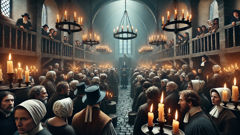
Willem, still weak from his wounds, stood trial first. His trembling voice protested innocence, but fear made reason scarce. The evidence was little more than rumor: a book of old Latin prayers mistaken for a grimoire, a hidden flask of brandy labeled as witch’s brew. When pressed, Willem broke down, confessing to whatever Hendrik wished—if only to end the ordeal. He named others: two farmhands who’d disappeared after the last raid, a tinker who never attended church.
The list grew. Even Katrijn was called before the tribunal. Her grief and isolation made her an easy target. Jan spoke in her defense, but suspicion had already turned the crowd against her. “She talks to the forest,” muttered one woman. “She found a Buckrider’s charm on her doorstep,” said another.
The tribunal demanded more confessions. Some gave them willingly, others under duress. Jan felt himself sinking into despair, powerless to halt the madness consuming his home.
Then, in a desperate act to clear Katrijn’s name and reveal the truth, Jan sought out Hendrik in private. He revealed what he’d seen in the forest: a band of desperate souls, not devils, but men and women crushed by poverty and fear. He described their leader, the camp, the goats—not as supernatural steeds but stolen livestock pressed into service by cunning and desperation.
Hendrik listened with a skeptic’s ear, but something in Jan’s conviction moved him. He agreed to lead one last search party—quietly, without fanfare or torches—to find proof one way or another.
That night, a small group slipped into the woods. Jan guided them by memory, heart hammering with every step. The mist clung to them; the trees pressed close. At last they reached the hidden clearing—but it was empty. Only smoldering ashes and a few goat tracks remained. The Buckriders had vanished like smoke.
Yet among the ashes, they found evidence: stolen goods, farmers’ tools, and, most damningly, a ledger listing names—some of them villagers who had confessed under torture, others who’d disappeared without a trace.
Armed with this proof, Hendrik returned to Oud-Heerlen. He denounced the tribunal’s methods, freed the accused, and exposed the crimes for what they were: the work of desperate people, not demons. But the legend endured. The villagers still whispered of Buckriders in the night—of flying goats and deals with the devil. The truth could not erase the fear rooted deep in their hearts.
Jan and Katrijn watched as Hendrik rode away. They understood now that legends grow from suffering, that fear can make monsters out of men, and that only courage—quiet, steadfast, and kind—can scatter shadows long enough to let the dawn break.
Conclusion
The legend of the Buckriders would haunt Limburg for generations—etched into local memory, painted on old tavern signs, whispered around kitchen tables on stormy nights. The flying goats, infernal bargains, and masked raiders became symbols of a time when fear held sway and justice struggled to find its footing. Yet behind the myth lingered a deeper truth: that in times of hardship, even honest folk may be tempted to darkness; that rumors wield power as sharp as any blade; and that the line between monster and man is often drawn by desperation and belief. Jan and Katrijn survived those troubled years with scars both seen and unseen. The village, too, learned hard lessons about suspicion and mercy. With each passing spring, the wounds healed a little more—though, sometimes, on nights when the mist rose thick across the moors and a goat bleated in the dark, even the bravest among them would glance over their shoulder and wonder what still lurked in the shadows. Thus the legend endures: not as simple superstition, but as a warning—and a hope—that even in the blackest night, some flicker of humanity will light the way home.

